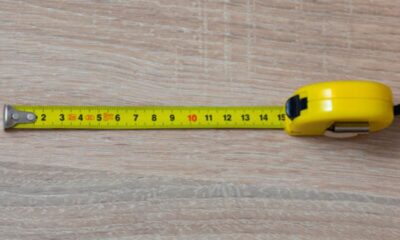Education
58 Inches: Exploring Measurement and Practical Applications

Inches, a unit of measurement commonly used in the United States and other countries, provide a versatile way to quantify length, height, width, and more. Among the myriad of measurements that exist, 58 inches holds significance in various contexts, from clothing sizes to household items and beyond. In this article, we’ll delve into the world of inches, explore the value of 58 inches, discuss its practical applications, and examine how it can be converted into other units of measurement.
Understanding Inches:
Before delving into the specific value of 58 inches, let’s first establish a foundational understanding of inches as a unit of measurement. An inch is a unit of length in the imperial and United States customary systems, equal to 1⁄12 of a foot. It is typically denoted by the symbol “in” or double quotes (“). Inches are commonly used in everyday situations, such as measuring the height of a person, the width of a doorway, or the length of a piece of fabric.
58 Inches: Exploring the Value:
Now that we have a grasp of what inches represent, let’s turn our attention to the value of 58 inches. At 58 inches, we are dealing with a measurement of length or height that falls just shy of 5 feet. To put it into perspective, here are a few examples of objects or dimensions that may measure approximately 58 inches:
1. Average Adult Height: In some regions, an individual’s height of around 58 inches (4 feet 10 inches) may be considered within the range of average adult height, although this can vary significantly based on factors such as gender, genetics, and ethnicity.
2. Standard Bathtub Length: Many standard bathtubs have a length of around 58 inches, making them suitable for average-sized bathrooms and accommodating individuals of varying heights comfortably.
3. Medium-Sized Kitchen Table: A kitchen table with dimensions of approximately 58 inches in length can comfortably seat four to six people, providing ample space for dining and socializing.
4. Child’s Bicycle: Bicycles designed for children or smaller adults may have a wheelbase (the distance between the centers of the front and rear wheels) of around 58 inches, making them suitable for riders of a certain height range.
Conversion to Other Units:
While inches provide a convenient way to measure length, height, and width, it’s often necessary to convert between different units of measurement for practical purposes. Let’s explore how 58 inches can be converted into other common units of length:
– Feet: Since there are 12 inches in a foot, we can divide it by 12 to convert to feet. This yields approximately 4.83 feet, or 4 feet 10 inches when expressed as a mixed number.
– Centimeters: To convert inches to centimeters, we can use the conversion factor of 1 inch = 2.54 centimeters. Multiplying 58 inches by 2.54 gives us approximately 147.32 centimeters.
– Meters: Similarly, to convert inches to meters, we divide the number of inches by 39.37 (the number of inches in a meter). Thus, it is approximately 1.47 meters.
Practical Applications:
The value of 58 inches finds practical applications across various domains, from fashion and construction to healthcare and interior design. Here are a few examples of how this measurement is utilized in everyday contexts:
– Clothing Sizing: In the realm of fashion, it may correspond to the bust, waist, or hip measurements for certain clothing sizes, particularly in petite or custom sizing categories.
– Furniture Dimensions: When selecting furniture for a home or office space, knowing the dimensions in inches can help ensure that pieces fit comfortably within the designated area. This applies to items such as sofas, beds, tables, and shelving units.
– Healthcare Assessments: Healthcare professionals may use measurements such as height (in inches) to assess growth and development in children, monitor changes in adult height over time, or calculate body mass index (BMI) for individuals of various heights.
– Construction and Carpentry: In construction and carpentry projects, precise measurements are essential for ensuring accuracy and functionality. Builders and craftsmen may use as a reference point when cutting materials or determining the dimensions of structural components.
Conclusion:
Inches serve as a fundamental unit of measurement that plays a crucial role in quantifying length, height, and width in various contexts. At 58 inches, we encounter a measurement that holds significance in everyday life, from estimating average adult height to selecting furniture and assessing healthcare indicators. By understanding the value of 58 inches and its practical applications, we gain insight into the importance of precise measurements and the role they play in our daily routines and decision-making processes. Whether used in fashion, construction, healthcare, or beyond, inches continue to serve as a versatile and indispensable tool for quantifying the world around us.
Education
15 cm to Inches how to Convert: The Art of Centimeter to Inch Conversion

15 cm to Inches, everyday life presents us with several opportunities to do unit conversions. Unit conversions are useful for many different reasons, including home repair projects and schoolwork. In this post, we will learn how to convert 15 cm to Inches, as well as discuss the relevance of this and other frequent conversions.
What is the Conversion Factor?
Knowing how many centimetres equal how many inches is necessary background reading. There are exactly 2.54 centimetres in one inch. All conversions from centimetres to inches use this factor.
How to Convert Centimeters to Inches
The procedure of converting centimetres to inches is simple. The following formula may be used to convert any length expressed in centimetres to inches:
Length (in inches) = Length (in centimeters) / 2.54
The Formula for Converting cm to inches
Let’s break down the formula. To convert 15 cm to Inches , you would divide 15 by 2.54:
So, 15 centimeters is approximately equal to 5.91 inches.
Why Do We Need to Convert These Units?
Converting from centimetres to inches may seem pointless at first. The context usually dictates whether one uses centimetres or inches. Some regions of the globe more widely use the metric system, which includes centimeters, while others commonly use the imperial system, which includes inches. Fluency in both systems is required for effective international interaction across cultural boundaries.
Practical Applications
There are many real-world uses for knowing how to convert centimetres to inches. It’s crucial for global commerce, as both metric and imperial measurements of products are required. In addition, it finds use in industries including building, decorating, and tailoring, all of which depend on accurate sizing.
Similar Conversions
To convert between any two lengths, all you need to know is the conversion factor of 2.54. Divide millimetres by 25.4 to get inches, and multiply feet by 0.3048 to get metres.
Historical Perspective
There’s a lot of interesting backstory behind these squads. While the Romans introduced the inch to the metric system, the centimetre was introduced much later. A greater appreciation for these measures is possible with knowledge of their historical setting.
Fun Facts About Inches
Did you know that internationally, one inch is equivalent to exactly 2.54 centimetres? It is one of the few units with a well-defined metric system.
The Importance of Accuracy
It is crucial to be precise while taking measurements, as even a slight deviation might have major consequences. When dealing with lengths, be sure to always use the appropriate unit and do proper conversions.
Tools for Conversion
There are a number of convenient centimeter-to-inch conversion tools available. The precision of your measurements may be improved by using tools like rulers, calculators, and even applications on your smartphone.
Online Conversion Calculators
Now that we live in the digital era, conversion calculators are easily accessible online. Converting centimetres to inches is a breeze with the help of online tools or mobile apps.
Common Mistakes to Avoid
It’s easy to make a mistake while converting units, such as by applying the incorrect conversion factor or by rounding off too soon. Always round off your final answer, not your calculations, to the exact factor of 2.54.
Conclusion
Converting 15 cm to Inches is a useful ability, and knowing the conversion factor between the two units is even better. Knowing how to convert units helps bridge the gap between different measuring systems, which is useful whether you’re travelling, working on a project, or just inquisitive about the world around you. Therefore, you will be prepared to deal with a unit conversion the next time you come across one.
FAQs
- Is 2.54 the only conversion factor between centimeters and inches?
No, 2.54 is the standard conversion factor. However, for precise conversions, it’s always best to use this exact figure. - Why do some countries prefer inches over centimeters?
Historical and cultural factors play a role in the choice of units. Some countries have a tradition of using the imperial system, which includes inches. - Are there any industries where centimeters are more commonly used than inches?
Yes, the metric system, including centimeters, is the primary system used in scientific research, engineering, and healthcare. - Can I use approximate conversions in everyday situations?
While approximate conversions may be acceptable for casual use, precision is crucial in fields like science, engineering, and construction. - Are there any other units that use the 2.54 conversion factor?
Yes, the same factor is used when converting millimeters to inches, making it a versatile tool for various length measurements.
READ MORE
Education
410 Inches: From Nature’s Wonders to Technological Marvels

At first glance, the number 410 inches may seem arbitrary or inconsequential, but upon closer inspection, it reveals itself to be a measurement of considerable significance. In this article, we will delve into the myriad contexts in which the measurement of 410 inches holds importance, from the natural world to the realm of technology and beyond. Join us on a journey of exploration as we uncover the magnitude and implications of 410 inches.
Nature’s Wonders: 410 Inches in the Wilderness
In the realm of nature, 410 inches can represent the height of majestic trees, the length of awe-inspiring waterfalls, or the span of magnificent geological formations. Consider, for example, the towering sequoias of California’s Sierra Nevada, some of which reach heights exceeding 410 inches, making them among the tallest living organisms on Earth. These ancient giants serve as a testament to the resilience and grandeur of nature, inspiring awe and reverence in all who behold them.
Alternatively, 410 inches could denote the length of a mighty waterfall, cascading down rocky cliffs with breathtaking force and beauty. Whether it’s the iconic Niagara Falls or the majestic Angel Falls in Venezuela, waterfalls measuring 410 inches or more captivate the imagination and draw visitors from around the world to witness their splendor firsthand.
In the realm of geology, 410 inches might signify the span of a massive rock formation, such as the towering cliffs of the Grand Canyon or the imposing granite monoliths of Yosemite National Park. These geological wonders stand as enduring testaments to the forces of erosion and uplift that have shaped the Earth’s surface over millions of years, offering a glimpse into the planet’s tumultuous past.
Architectural Marvels: 410 Inches in Construction
In the world of architecture and construction, 410 inches can represent the height of skyscrapers, the length of bridges, or the span of expansive structures. Imagine, for instance, the towering spires of the world’s tallest buildings, reaching heights of 410 inches or more and piercing the sky with their sleek, modern designs. From the Burj Khalifa in Dubai to the Shanghai Tower in China, these architectural marvels stand as symbols of human ingenuity and ambition, pushing the limits of what is possible in the realm of construction.
Alternatively, 410 inches might denote the length of a sprawling bridge, spanning rivers, bays, or canyons with graceful arches or sturdy trusses. Bridges such as the Golden Gate Bridge in San Francisco or the Akashi Kaikyō Bridge in Japan demonstrate the engineering prowess required to construct such monumental structures, facilitating transportation and commerce while serving as iconic landmarks in their own right.
In the realm of infrastructure, it could signify the span of a massive dam, harnessing the power of rivers and streams to generate electricity, control flooding, and provide water for irrigation and consumption. Dams such as the Hoover Dam in the United States or the Three Gorges Dam in China represent feats of engineering on an epic scale, reshaping landscapes and transforming the flow of rivers to meet the needs of growing populations.
Technological Advancements: 410 Inches in Innovation
In the realm of technology, it can represent the size of cutting-edge displays, the capacity of high-performance hard drives, or the reach of advanced communication networks. Consider, for example, the expansive screens of modern televisions and monitors, measuring it or more diagonally and providing viewers with immersive experiences that rival those of movie theaters and concert halls. These high-definition displays leverage the latest in display technology to deliver stunning visuals and lifelike images, blurring the lines between reality and virtuality.
Alternatively, 410 inches might denote the storage capacity of state-of-the-art hard drives, capable of storing vast amounts of data in compact, portable form factors. Whether it’s for personal use or enterprise applications, these high-capacity drives enable users to store, access, and share large volumes of digital content with ease, fueling the growth of cloud computing, big data analytics, and other data-intensive technologies.
In the realm of telecommunications, it could signify the reach of advanced communication networks, spanning continents and oceans to connect people and devices in real-time. From fiber optic cables that transmit data at the speed of light to satellite networks that provide global coverage, these communication infrastructures enable instant communication and collaboration on a scale never before imagined, revolutionizing how we work, play, and connect with one another.
Conclusion: The Significance of 410 Inches
The measurement of 410 inches holds considerable significance across a wide range of contexts, from the natural world to the realms of construction, technology, and beyond. Whether it’s the height of towering trees, the span of majestic waterfalls, the height of skyscrapers, the length of expansive bridges, the capacity of high-performance hard drives, or the reach of advanced communication networks, 410 inches serves as a reminder of the magnitude and complexity of the world in which we live.
As we continue to push the boundaries of what is possible in the realms of science, engineering, and innovation, it is certain that the significance of will only continue to grow, serving as a benchmark for achievement and a symbol of human ingenuity and ambition. So, the next time you encounter the measurement of 410 inches, take a moment to appreciate the magnitude of its significance and the myriad wonders it represents.
Education
Nurturing Young Faith: Contemporary Methods for Teaching Biblical Values to Children

Key Takeaways
- Adaptable teaching methods are vital to connect with children’s ways of learning.
- Technology and creative storytelling enrich religious education.
- Object lessons offer a tangible grasp of abstract ideas.
- Parental involvement is influential in reinforcing religious teachings.
The Importance of Adaptability in Religious Education
As society shifts with technological advancements and cultural changes, religious education adapts, finding new avenues to convey age-old truths to younger audiences. The value of adaptability cannot be overstated, as it entails a willingness to revise teaching techniques and incorporate resources that appeal to today’s youth. A prime example of instructional innovation is object lessons for kids, which embody a hands-on approach to learning and symbolically represent the spiritual messages of scripture.
Modern children are immersed in a multimedia world, so lessons that blend tradition with technology speak a language they understand. By employing adaptive methods, educators ensure that spiritual lessons retain relevance and vibrance, making faith an exciting and integral part of children’s lives. This alignment of teaching methodology with contemporary learning environments fortifies the connection children have with their faith, allowing for a more profound, resonant spiritual experience.
Integrating Technology into Kids’ Ministry
Technology has significantly impacted children’s ministry, revolutionizing biblical instruction through the strategic use of multimedia and digital resources. This approach aligns with the communicative habits of today’s youth, providing enjoyable and interactive learning experiences through visual story apps and online platforms. In the church context, this might involve projectors displaying vivid illustrations during lessons or kids’ ministry software tracking learning progress. Virtual platforms also enable children to connect, learn, and grow in faith from a distance. This interplay between faith and technology makes instruction accessible and relatable, drawing children into faith-based communities and encouraging spiritual exploration.
Creative Storytelling Techniques
Storytelling is a crucial aspect of education, particularly in biblical contexts. It can transform ancient texts into relatable lessons for children, bridging the past to the present through stories children can relate to. Using relatable characters in religious education helps children understand moral and ethical living more deeply. By repackaging biblical narratives with modern creative storytelling techniques, religious educators offer a fresh perspective, allowing children to relate to scripture personally and engagingly. By incorporating relatable characters, children can apply these lessons to their lives, fostering a deeper understanding of morality and ethics.
Object Lessons and Their Impact on Learning
Object lessons are a dynamic and tactile form of instruction that apply physical items to manifest esoteric spiritual concepts tangibly. Through these lessons, children can connect to abstract faith teachings, such as grace or forgiveness, by associating them with everyday objects. This method not only engages multiple senses but also catalyzes reflection and curiosity. The symbolic representation fosters a memorable learning experience, grounding lofty ideas in the concrete world that children can touch and see.
Role-Playing Scenarios in Bible Studies
Role-playing is a method that enhances children’s learning experience by allowing them to participate in biblical study sessions. By imagining the lives of biblical heroes and heroines, children can understand their moral decisions and experiences, fostering a deeper connection with the scriptural lessons. This approach also encourages children to consider the real-world applications of the biblical stories, making them relevant to their contemporary circumstances. Furthermore, role-playing fosters social interaction and cooperative play, reinforcing the principles of community and fellowship in faith traditions.
Incorporating Art and Craft in Teaching the Bible
Art and craft activities are practical tools for doctrinal instruction, combining creativity with learning. Children can explore spirituality through creative expressions like clay sculptures or Bible paintings. These activities allow them to interpret scripture and express their insights in vibrant, colorful depictions. Visual and hands-on activities reinforce instructional material in ways that lectures or reading alone cannot. By fostering creativity within religious lessons, educators can cater to diverse learning styles and a broader range of children’s unique perspectives on faith.
Cognitive Benefits of Engaging Bible Lessons
Engaging in Bible lessons not only benefits the spirit but also has cognitive benefits. Scriptural education encourages critical thinking, problem-solving, and analytical thinking, preparing children for complex thought processes. Active participation and discussion in Bible lessons enhance verbal abilities, nuanced understanding, and vocabulary. It also improves narrative comprehension and communication skills, demonstrating the multifaceted benefits of interactive religious education programs. Overall, Bible lessons provide a comprehensive and enriching educational experience for children.
The Role of Parents in Reinforcing Learned Biblical Themes
Biblical teachings for children are mostly reinforced and personalized in the family context. Parents’ active participation in their child’s religious education can significantly enhance their spiritual development. Engaged parenting through open discussions, storytelling, and scripture-related crafts can enrich a child’s spiritual growth. Churches and ministries can support parents by providing resources that parallel classroom lessons, such as weekly summaries, multimedia resources, and interactive family devotionals. This level of involvement enhances the educational process and fosters a bond-strengthening environment, nurturing a child’s growth in a loving family environment.
Measurement of Success in Kids’ Ministry
Religious education success is not solely measured by attendance or completion of the biblical worksheet. It’s more about the quality of engagement and understanding children demonstrate. Observing how children apply lessons, their willingness to participate, and their consistent spiritual practices provide insights into the program’s effectiveness. Feedback from children and parents is crucial for evaluating and refining educational strategies. Churches can use surveys, family meetings, and open communication with leadership to ensure the educational offerings align with the needs and expectations of their families.
Future Directions in Kids’ Ministry
The kids’ ministry faces a landscape of innovation and flexibility, requiring educators and spiritual leaders to blend tradition with contemporary methods and stay updated with emerging trends in education and technology. It requires creativity, insight, and dedication to delivering Bible messages in new ways. The goal is to enhance the transmission of timeless truths to a potential generation, creating a nurturing environment that empowers the next generation to integrate spiritual guidance in the modern world.
Reputable resources such as the Pew Research Center, which offers a comprehensive overview of the shifting landscape of faith in the modern age, can provide deeper insights into how technology influences religious practices.
-

 Technology6 months ago
Technology6 months ago社工库: Navigating the Depths of Social Engineering Databases
-

 News4 months ago
News4 months agoFinding the Truth Behind a Trails Carolina Death
-

 Education5 months ago
Education5 months agoFortiOS 7.2 – NSE4_FGT-7.2 Free Exam Questions [2023]
-

 Technology1 month ago
Technology1 month agoAmazon’s GPT-55X: A Revolutionary Leap in AI Technology
-

 Education6 months ago
Education6 months agoExploring the Significance of 92career
-

 News6 months ago
News6 months agoClaudia Goldin: A Trailblazer in Understanding Gender Pay Gap
-

 General6 months ago
General6 months agoPower of XCV Panels: Revolutionizing Modern Technology:
-

 Entertainment4 months ago
Entertainment4 months agoFree Tube Spot: Your Gateway to Endless Entertainment












